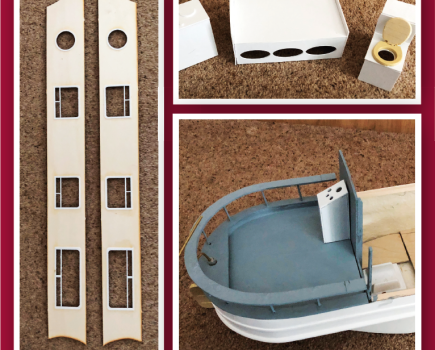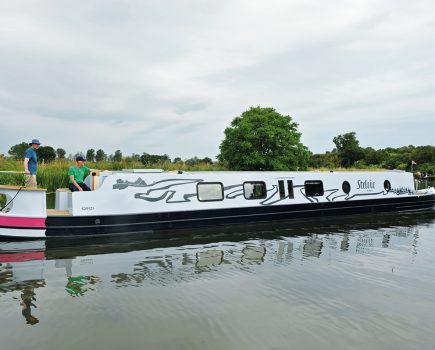Boating
LINE UP FOR THE LOCK
Q: I do most of my boating on a river where the lock mooring jetties are usually short and quite close to the lock and where there are also sometimes crosswinds and currents that act to hold you against them. As a result it can be quite hard to get off the jetty, out into the stream and properly lined up for a lock in order to be able to get through it without a lot of unpleasant metal against concrete noises! A: You need to ‘spring the stern’. Get the tiller arm towards the jetty, then reverse using power. You have to be quite quick with the throttle. Put it in neutral with the tiller over the other way; then forward, but not too hard – just enough to keep the stern moving out. Neutral again, then reverse back and straighten out, all with power, into the lock.
BROAD OR NARROW?
Q: I have recently enjoyed a trip on the Llangollen canal with the Black Prince company and would like to know a little more about ‘wide beam’ boats. I am 6ft 4 and 18 stone, and as you can imagine the narrowboat we hired was a squeeze in some places! My question is this; If I were to buy a wide beam boat, what are restrictions regarding travelling along the various canal routes around the country?
A: The narrow canals were built to standard dimensions that would accommodate a boat of a little over 70ft long by approximately 7ft wide. However the waterways for broader craft tend to be based on the numerous regional river craft types and therefore follow no such standard. Some of them have been rebuilt for navigation purposes to different sizes, so that boat lengths that can use them now vary from under 50ft (parts of the Middle Level) to over 100ft, and widths from just under10ft on the north end of the Trent & Mersey and Shropshire Union to nearer 20ft.But assuming a craft no larger than 57ft (which will only exclude you from the Old Bedford River and the top of the Little Ouse) by 10ft, the broad beam waterways can be divided into four main areas: The North: including the Leeds & Liverpool, Rochdale, Aire & Calder, Calder & Hebble, Sheffield & S Yorks, Bridgewater, Weaver, Trent, Yorkshire Ouse and connections, Soar, Erewash, Fossdyke, Witham and parts of the Trent & Mersey and GU Leicester Section. The East: including the Great Ouse and tributaries, Nene, and Middle Level.The South East: including the Thames, Kennet & Avon, GU Main Line, Regents, Lee, Stort, Wey and Basingstoke.The South West: Severn, Gloucester & Sharpness and Warwickshire Avon.The problem is that they don’t all link together! Those who are prepared to cross The Wash can get between the North and East areas (and the proposed Fens Link would make an easier route between these two waterways).Craft suitable for the journey from Avonmouth via the Bristol Channel to Sharpness can access both the South West and the South East. There is, however, no broad beam inland waterway link between northern and southern networks. At least three have been suggested. One or more may well become a reality, we would not advise anyone to base their choice of a broad beam craft on the assumption that any will be open in the near future.
BACKING UP
Q: Can you please enlighten me as to how to steer a narrowboat in reverse? A friend of mine recently spent a day on a boat and related that he found it impossible to steer in reverse. He asked me how as a boat owner I managed it – I had to confess that even in still air conditions the boat just seems to go wherever it chooses, so before it goes too far off course, I select forward gear, give it a quick blast with the rudder aimed as required to correct the course and then continue in reverse, repeating as and when necessary.A: You are, of course correct, taking a narrowboat astern is not easy and, because the propeller and rudder are at the leading end of the vessel, the helmsman has very little control of the bow. This low level of control – I estimate only about five per cent – means that the vessel is very vulnerable to attack from wind and current. However, in favourable conditions and with practice, most narrowboats can be controlled; many of our students, successfully steer our training vessel over 100 metres stern first along the canal. Preparation and concentration are essential to a controlled manoeuvre – here are a few tips:The vessel MUST be stopped (both backwards and forwards and left/right). Point the vessel in the required direction BEFORE engaging reverse gear. Find the best engine speed for your boat, usually a little over tick over. Spend 90 per cent of the time closely monitoring the movement of the bow and correct the swing IMMEDIATELY as more than a few inches of swing will prevent you from making a correction without going into forward gear. Never stand behind the swing of the tiller: if the rudder hits an underwater object, the helmsman could be knocked overboard and run down by his own vessel!Finally, as in all boathandling skills, ‘Practice makes Perfect’ but if that doesn’t produce the level of expertise that you wish, try an RYA training course, they are not just for the novice. I am sure that my training colleagues at other Centres are like me and enjoy the challenge of ‘fine tuning’ an already experienced boathandler.
ANCHORS – THE LOW-DOWN
Q: Can you explain the use of an anchor on a narrowboat? What lengths of chain and cable do I need?A: An anchor can be used to good effect on rivers where moorings can be hard to find. You can anchor where you like (within reason), it costs nothing and there are no time limits – except on the non-tidal Thames where it is 24 hours. Firstly, you need the correct anchor for your boat – the weight depends on the weight and length of your boat. You will need a 15kg Danforth anchor or better for a large narrowboat. If you intend to anchor overnight an all-round white light is essential.You should have approximately six times the length of cable (rope) to the depth of water – too long is better than too short – with 10 to 15ft. of tackle (chain). The chain ensures the anchor pulls at a near-horizontal angle to the river bottom. Ensure the cable is always attached to the boat at its free end!Turn the boat to face upstream and pay the anchor out as you stop the boat. Make sure fingers and feet are out of the way of the uncoiling rope. Slowly reverse until the correct amount is out. Make fast. Engage reverse gear with a little extra power to help the anchor “dig in” for good grip. You could add a tipping line to the bottom of the anchor (a thinner rope with a float attached) if you are concerned it could become stuck.Weighing the anchor can be rather heavy, wet, cold and dirty but the experience is worth it for the satisfaction of having completed a nice bit of seamanship in a professional manner. Engage forward gear with a little power to take the load off the rope. If unable to raise the anchor with the tipping line make the anchor line fast when the rope is upright and let the momentum of the boat break it out.
To ask a question click here







